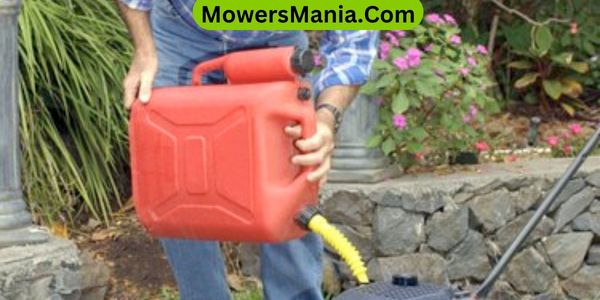Are you struggling with a damaged plastic gas tank on your lawn mower? Don’t worry, we’ve got you covered.
In this article, we will guide you through the step-by-step process of fixing your gas tank. With a few simple tools and materials, you’ll be able to repair the leaks and get your lawn mower back up and running in no time.

Let’s get started!
Assess the Damage
Assessing the damage can be done by carefully inspecting the plastic gas tank on your lawn mower. Begin by visually examining the tank for any visible cracks, leaks, or bulges.
Look closely at the seams and edges, as these areas are more prone to damage. If you notice any signs of damage, such as discoloration or warping, it’s important to address it promptly.
Next, gently press on the tank to check for any soft spots or areas that give way under pressure. This could indicate weakening of the plastic and potential future leaks.
Pay attention to any unusual smells or fumes coming from the tank, as this may suggest a leak or damage to the fuel system.
Additionally, inspect the fuel lines and connections for any signs of wear or damage. Look for cracks, splits, or loose fittings that may be causing fuel leakage.
It’s crucial to address any issues with the fuel lines or connections to prevent further damage to the plastic gas tank.
Safety Precautions
Before you begin fixing the plastic gas tank on your lawn mower, it’s crucial to prioritize safety. Make sure to wear the necessary protective gear, such as gloves and safety goggles, to prevent any potential injuries.
Additionally, handle all flammable materials with caution and take steps to prevent fire hazards, such as avoiding open flames and keeping a fire extinguisher nearby.
Protective Gear Importance
Make sure you have the necessary protective gear before attempting to fix the plastic gas tank on your lawn mower.
Your safety should always be a top priority when working with potentially hazardous materials. Here are three essential items of protective gear to ensure your well-being:
Handling Flammable Materials
When working with flammable materials on your lawn mower, it is important to take necessary safety precautions.
These materials can pose a serious fire hazard if mishandled. To ensure your safety, follow these guidelines:
| Safety Precautions |
|---|
| 1. Work in a well-ventilated area to prevent the accumulation of flammable vapors. |
| 2. Keep a fire extinguisher nearby in case of emergencies. |
| 3. Avoid smoking or using open flames in the vicinity of flammable materials. |
| 4. Use appropriate containers to store and transport flammable liquids. |
| 5. Wear protective gear, such as gloves and goggles, to shield yourself from potential hazards. |
Preventing Fire Hazards
To prevent fire hazards, it’s essential that you continue to adhere to the safety precautions mentioned earlier when handling flammable materials on your lawn mower.
Here are three important safety precautions to remember:
- Store gasoline in approved containers: Always use containers specifically designed for storing flammable liquids like gasoline. These containers should be made of materials that can withstand the corrosive nature of gasoline and prevent leaks or spills.
- Keep a fire extinguisher nearby: Accidents can happen, so it’s crucial to have a fire extinguisher within reach in case of an emergency. Make sure it’s suitable for extinguishing flammable liquid fires and that you know how to use it properly.
- Regularly inspect and maintain your lawn mower: Check for any signs of damage or wear on the fuel system, including the gas tank, fuel lines, and fittings. Replace any damaged parts immediately to prevent leaks and potential fire hazards.
Gather the Necessary Tools and Materials

To gather the necessary tools and materials for fixing the plastic gas tank on your lawn mower, you’ll need an assortment of items.
First and foremost, you’ll need a replacement gas tank that’s compatible with your specific lawn mower model. Make sure to check the measurements and specifications to ensure a proper fit.
Additionally, you’ll need a set of screwdrivers, both Phillips and flathead, to remove any screws or fasteners holding the gas tank in place. A pair of pliers will also come in handy for gripping and maneuvering any stubborn parts.
To seal any leaks or cracks in the tank, you’ll require a plastic epoxy adhesive. This adhesive is specifically designed for repairing plastic components and creating a strong, long-lasting bond.
Lastly, be sure to have a clean cloth or rag on hand to wipe away any excess adhesive or dirt during the repair process.
Drain the Gas Tank
To drain the gas tank on your lawn mower, follow these steps:
Repair the Leaks
To repair the leaks in the plastic gas tank of your lawn mower, you’ll need to assess the extent of the damage. Start by visually inspecting the tank for any visible cracks or holes.
Use a flashlight to get a closer look, as some leaks may be small and difficult to spot. Next, fill the tank with water and observe if any water seeps out. If water is leaking, this indicates a hole or crack that needs to be repaired.
Once you have identified the leaks, you can proceed with the repair process. Begin by draining any remaining gas from the tank and ensuring it’s completely empty.
This will prevent any accidental ignition during the repair. Clean the area around the leaks using a mild detergent or soap to remove any dirt or debris.
For smaller leaks, you can use a plastic repair epoxy or a fuel tank repair kit. These products are specifically designed to seal cracks and holes in plastic gas tanks.
Follow the instructions provided with the repair kit for best results. Apply the epoxy or repair compound to the affected area and allow it to cure according to the recommended time frame.
For larger or more extensive leaks, it may be necessary to replace the entire gas tank. Contact the manufacturer or a local lawn mower repair shop to source a replacement tank. Follow the instructions provided by the manufacturer for proper installation.
Remember to always prioritize safety during the repair process. Work in a well-ventilated area, away from any open flames or sparks. Wear gloves and protective eyewear to prevent any injuries.
Reassemble the Gas Tank
Now, it’s time for you to reassemble the gas tank using a double preposition. Follow these simple steps to successfully put the gas tank back together:
Align and Secure:
- Make sure the tank’s mounting holes are aligned with the corresponding holes on the mower.
- Gently lower the tank onto the mower and secure it in place using the bolts or screws provided.
- Tighten them just enough to hold the tank securely without overtightening and damaging the plastic.
Connect the Fuel Line:
- Locate the fuel line that connects the tank to the engine.
- Insert the end of the line into the fuel outlet on the tank, ensuring a tight fit.
- If the line has a clamp, use pliers to secure it in place.
- Double-check that the connection is secure to prevent any fuel leaks.
Reattach the Cap:
- Place the gas cap on the tank’s opening and twist it clockwise until it’s snug.
- Ensure that the cap is properly sealed to prevent fuel from evaporating or spilling out.
Test and Refill the Gas Tank

To ensure proper gas tank maintenance, it’s important to test and refill the tank regularly. Start by checking for any leaks or cracks in the tank before refilling it with fresh gasoline.
Remember to follow safety precautions such as working in a well-ventilated area and avoiding open flames during the refilling process.
Proper Gas Tank Maintenance
Before you begin testing and refilling the gas tank, make sure to gather all the necessary tools and materials. Proper gas tank maintenance is essential for the longevity and performance of your lawn mower.
Here are three key steps to follow:
- Test the gas tank: Start by visually inspecting the tank for any cracks, leaks, or damage. Check the fuel gauge to ensure it’s accurate and working properly. If you suspect a problem, it’s best to replace the gas tank to avoid any potential hazards.
- Empty and clean the tank: If you notice any debris or sediment in the tank, empty it completely and clean it thoroughly. Use a mixture of soap and water to remove any dirt or residue. Rinse it well and let it dry before refilling.
- Refill the gas tank: Use fresh, clean gasoline to refill the tank. Avoid using old or contaminated fuel as it can cause engine problems. Fill the tank to the recommended level, taking care not to overfill.
Safety Precautions When Refilling
When refilling the gas tank on your lawn mower, always take safety precautions to avoid any potential hazards.
When refilling the gas tank, use a funnel to avoid any spills or splashes. Be careful not to overfill the tank, as this can cause fuel to overflow and create a fire hazard.
Frequently Asked Questions [FAQs]
Can I Use Any Type of Adhesive to Repair the Plastic Gas Tank?
You can’t use any type of adhesive to repair the plastic gas tank on your lawn mower. It requires a specific plastic repair epoxy that is designed to bond and seal plastic surfaces.
How Long Does It Usually Take to Drain the Gas Tank?
It usually takes around 10-15 minutes to drain the gas tank. Make sure to turn off the engine and use a siphon or drain plug to safely remove the fuel.
Is It Necessary to Wear Protective Gloves and Goggles While Repairing the Gas Tank?
Yes, it is necessary to wear protective gloves and goggles while repairing the gas tank. This will ensure your safety and prevent any potential harm from chemicals or debris during the repair process.
Can I Still Use the Lawn Mower While the Gas Tank Is Being Repaired?
Yes, you can still use the lawn mower while the gas tank is being repaired. However, it is important to ensure that the repair is done properly and that there are no leaks.
What Are Some Common Signs of a Leaking Gas Tank on a Lawn Mower?
If you’re wondering about signs of a leaking gas tank on a lawn mower, keep an eye out for strong gasoline smell, visible fuel leaks, or difficulty starting the mower. These may indicate a problem.
Conclusion
Fixing a plastic gas tank on a lawn mower requires several steps. First, you need to assess the damage and determine the extent of the repairs needed. Once you have done that, it is important to take safety precautions to protect yourself from potential hazards. This includes wearing protective gloves and eyewear.
Next, you will need to drain the tank of any remaining gasoline. This can be done by either siphoning the gas out or using a hand pump. Make sure to collect the gasoline in a safe container for proper disposal later.
After the tank is empty, you can begin repairing any leaks. This may involve using a plastic welding kit or applying a strong adhesive to seal any cracks or holes. Make sure to follow the instructions provided by the manufacturer for the best results.
Once the repairs are complete, you can reassemble the tank by securely attaching any parts that were removed earlier. Double-check that everything is properly aligned and tightened to prevent any future leaks.
Finally, it is crucial to test the tank for any remaining leaks. You can do this by filling it with a small amount of gasoline and observing if any fuel escapes. If there are no leaks, you can safely refill the tank with fresh gasoline and resume using your lawn mower.
By following these steps and gathering the necessary tools and materials, you can successfully repair your lawn mower’s gas tank. Remember to always prioritize safety and take necessary precautions when working with gasoline.



